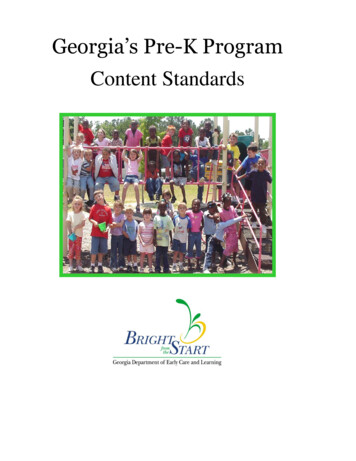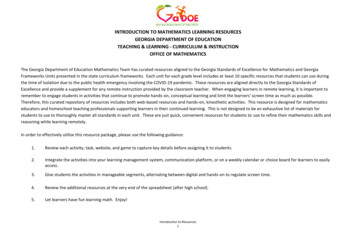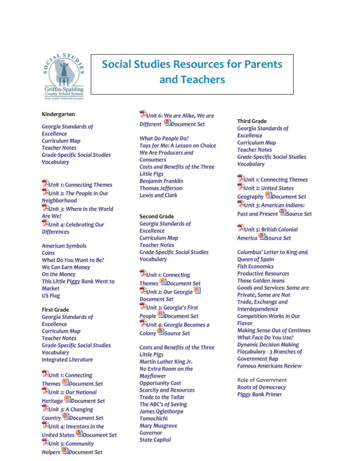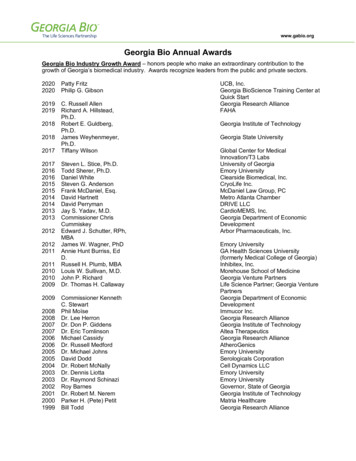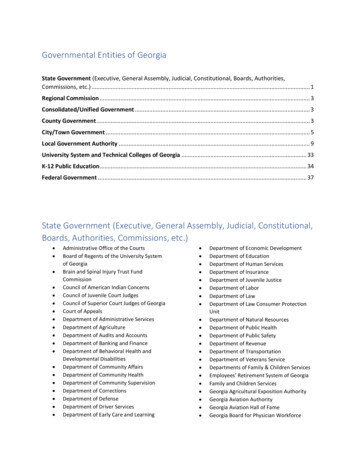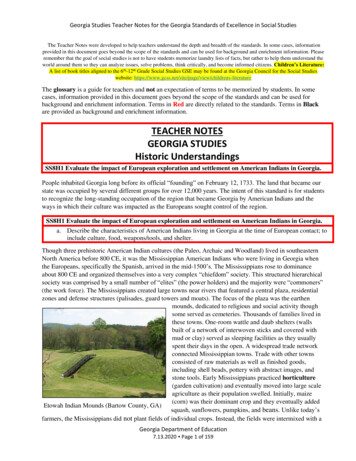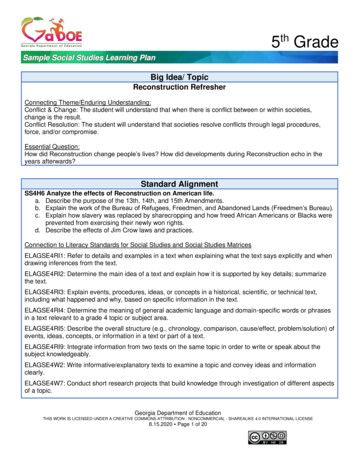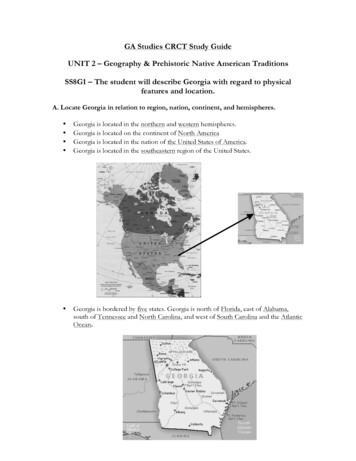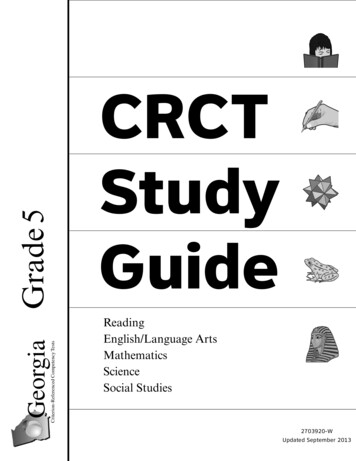
Transcription
Criterion-Referenced Competency TestsGeorgiaGrade 5CRCTStudyGuideReadingEnglish/Language ArtsMathematicsScienceSocial Studies2703920-WUpdated September 2013
Copyright 2013 by Georgia Department of Education.All rights reserved.
Table of ContentsUsing the CRCT Study Guide1About the CRCTOverview of the CRCTWhat is the CRCT?What does the CRCT measure?How are CRCT questions scored?2Preparing for the CRCTTest-Taking StrategiesRelated Links4Chapter 1ReadingReading Skills and Vocabulary AcquisitionLiterary ComprehensionInformation and Media LiteracyPractice QuizSolutions10Chapter 2English/Language ArtsGrammar/Sentence ConstructionResearch/Writing ProcessPractice QuizSolutions28Chapter 3MathematicsNumber and OperationsMeasurement and Data AnalysisGeometryAlgebraPractice QuizSolutions44Copyright 2013 by Georgia Department of Education.All rights reserved.
Chapter 4ScienceEarth SciencePhysical ScienceLife SciencePractice QuizSolutions68Chapter 5Social ractice QuizSolutions84Copyright 2013 by Georgia Department of Education.All rights reserved.
Using the CRCT Study GuideThis Study Guide focuses on the knowledge and skills that are tested on theGeorgia Criterion-Referenced Competency Tests (CRCT). It is designed forteachers to use with their students and for parents to use with their children.Go to www.gadoe.org/ to find further information about and support forthe CRCT.The following section of this guide, “About the CRCT,” contains an overview ofthe CRCT and test-taking strategies to review with your students.–The content tested on the CRCT is based on Georgia’s state-mandatedcontent standards, which describe what all students should know,understand, and be able to do.The chapters of this guide are organized by subject. In each chapter you canexplore the skills needed to succeed in a specific tested domain (grouping ofsimilar content standards). The subject chapters include a snapshot of eachdomain, instructional Activities that address covered skills, and a PracticeQuiz with annotated Solutions to help assess student progress.This document is intended as a student resource. Photocopying is allowed asneeded for student use.Copyright 2013 by Georgia Department of Education.All rights reserved.Page 1 of 106
About the CRCTOverview of the CRCTWhat is the CRCT?The Grade 5 CRCT is a state-mandated achievement test that measures thesubject areas of Reading, English/Language Arts, Mathematics, Science, andSocial Studies.What does the CRCT measure?The CRCT is designed to measure student acquisition and understanding ofthe knowledge, concepts, and skills set forth in the state-mandated contentstandards.The tests accomplish the following:–––Ensure that students are learningProvide data to teachers, schools, and schooldistricts so they can make better instructional decisionsProvide data for use in Georgia’s accountability measures and reports.CRCT results measure the academic achievement of students, classes,schools, school systems, and the state. This information can be used toidentify individual student strengths and weaknesses or, more generally,to measure the quality of education throughout Georgia.How are CRCT questions scored?The CRCT currently uses only selected-response (multiple-choice) questions.There are four choices for each question, labeled A, B, C, and D.Students are not compared to each other. They are measured on theirachievement in meeting the standards. Scores are reported accordingto three performance levels: Does Not Meet the Standard, Meets theStandard, and Exceeds the Standard. For more information, go to the CRCTwebsite t/Assessment/Pages/CRCT.aspx.Copyright 2013 by Georgia Department of Education.All rights reserved.Page 2 of 106
About the CRCTOverview of the CRCTSince the spring of 2006, performance on the Reading portion of the CRCThas been linked to the Lexile Framework for Reading. Visit t/Assessment/Pages/LexileFramework.aspx for more information on this national reading measure.Copyright 2013 by Georgia Department of Education.All rights reserved.Page 3 of 106
About the CRCTPreparing for the CRCTTest-Taking StrategiesWeeksBeforethe TestSet academic goals with students for the upcoming weeksand months (short and long term). Write down and poststudents’ goals where they can be seen at least once a day.Help students gather study materials ahead of time.Set up a place to work that is free of distractions.Build in time to review what was learned in the last study session.Divide assignments into manageable chunks. Studying for a longtime non-stop is not productive!Model and have students mark the main idea of each paragraphwith a pencil as they read. This will help them focus on whatthey are reading.Have students ask questions that arise while they are studyingand encourage them to find the answers.At the end of each study session, review what they have learned.Copyright 2013 by Georgia Department of Education.All rights reserved.Page 4 of 106
About the CRCTPreparing for the CRCTDay Beforethe TestRemind students to get a good night’s rest.Remind students that they can talk to a teacher or parentif they are feeling nervous about the test.Assure students that this test is only one measureof their knowledge.Duringthe TestRemind students of the following strategies to use during the test:Relax by taking slow, deep breaths.Read the directions carefully. Make sure you understandwhat you need to do. If you are not sure, ask the teacher.Read each question carefully.When you use scratch paper, make sure that you copythe problem correctly from the test onto your paper.You can underline and make marks on your test to helpyou while you work, but the only answers that will be scoredare those in the correct locations on your answer sheet.Fill in the corresponding circle fully when you chooseyour answer. Erase any marks outside of the circle.Use your time wisely. Leave a question blank if youare unsure of the answer, then return to it at the end.Don’t spend too much time on one question.Be sure to answer all of the questions.Review your answers when you have finished the test.Try to stay calm during the test. This is a chance for youto show what you know. Do the best you can!Copyright 2013 by Georgia Department of Education.All rights reserved.Page 5 of 106
About the CRCTPreparing for the CRCTRelated LinksBelow are links to important resources that contain information relatedto the CRCT.CCGPS/GPS Resources:www.georgiastandards.orgCRCT Content and-Assessment/Assessment/Pages/CRCT.aspxCCGPS/GPS Frameworks:www.georgiastandards.orgLexile Framework for pyright 2013 by Georgia Department of Education.All rights reserved.Page 6 of 106
The Study Guides are intended to serve asa resource for parents and students. Theycontain a few activities and short practicequizzes for each content area. They also provideteachers an additional tool for student practice.The standards identified in the Study Guidesaddress a sampling of the state-mandatedcontent standards. For the purposes of day-to-dayclassroom instruction, teachers should consultthe wide array of resources that can be found atwww.georgiastandards.org.Since different students have different strengthsand needs, the activities in this Study Guidecan be scaffolded for students who need moresupport, extended to challenge advancedstudents, or presented as is (with appropriatemodeling) for grade-level students.Copyright 2013 by Georgia Department of Education.All rights reserved.Page 7 of 106
Copyright 2013 by Georgia Department of Education.All rights reserved.
ReadingCopyright 2013 by Georgia Department of Education.All rights reserved.
Chapter 1ReadingStudents in Grade 5 expand and deepen the concepts, skills, and strategieslearned in earlier grades. Grade 5 students read and comprehend texts froma variety of genres (fiction, nonfiction, poetry, and drama) and subject areas(math, science, social studies, and English/language arts), and they make newconnections as they encounter new ideas and begin to study subjects in moreformal ways.The Reading activities focus on some of the concepts that are assessed on theGrade 5 CRCT Reading domains. These domains are as follows:n Reading Skills and Vocabulary Acquisitiono Literary Comprehensionp Information and Media LiteracyCopyright 2013 by Georgia Department of Education.All rights reserved.Page 10 of 106
Chapter OneReadingActivitiesn Reading Skills and Vocabulary AcquisitionCommon Core Georgia Performance Standards ELACC5.L.4 and ELACC5.L.5Within the Reading Skills and Vocabulary Acquisition domain, students learn avariety of skills to read and interpret difficult text. Students will determine themeaning of unknown and multiple-meaning words and phrases by using contextclues and applying their knowledge of common, grade-appropriate Greek andLatin affixes and roots as clues to the meaning of a word. Students will consultreference materials (e.g., dictionaries, glossaries, thesauruses), both print anddigital, to find the pronunciation and determine or clarify the precise meaningof key words and phrases. Students will also demonstrate an understanding offigurative language, word relationships, and nuances in word meaning. Studentswill recognize and explain the meaning of common idioms, adages, and proverbs,as well as use the relationship between particular words (e.g., synonyms,antonyms, homographs) to better understand each of the words.The following activities develop skills in this domain:–To reinforce students’ knowledge of words with multiple meanings, hold aWord Auction. Write words that have two or more meanings on index cards.(See the table below.) Hold one word up at a time in front of students.Working in small groups or pairs, students will race against each other tothink of as many different meanings of the word as they can. They will write adifferent sentence for each meaning of the word, and the student who comesup with the most meanings first will get the sale. If the word on the card isrun, act as the auctioneer and call out: Do we have one sentence for the wordrun? Going once, going twice one sentence . Students who have at least onesentence should raise their hand. If a lot of hands go up, continue calling out,Do we have two sentences for the word run? Do we have three sentences?etc., until the highest bid is reached. Do not declare, Sold! until students readtheir sentences to prove they have used the different meanings of the ght 2013 by Georgia Department of Education.All rights reserved.Page 11 of cktricktripwatchwind
Chapter OneReading–To familiarize students with dictionary entries, play Match My Word. Writeadvanced vocabulary words on individual index cards. Then write or paste theprinted definitions on separate index cards. Scramble the cards and passthem out. Students will walk around the room and engage each other inconversation as they try to find the match for their word or definition.Students with definition cards might say, My word can be a verb or a nounand can mean,, or. If alternate word choices areprovided in their definitions, they might also say, Another way to say my wordis. Students who have a word card might say, My word is.I think it means. Once students find their partners they should sitdown together and create a sentence with their word. At the end of thesentences they should indicate which part of speech they used. For example,if their word is estimate and they write the sentence, The woman will estimatethe charges, they should specify that they used estimate as a verb.–To develop students’ understanding of common Greek and Latin roots, createtree diagrams. Present students with a list of Greek and Latin root words andtheir meanings (see tables below). To show students how to start a treediagram, draw the trunk of a tree and write one of the root words at thebottom. Draw branches that lead away from the trunk. On each branch write adifferent word that shares the root word. If the root word is port, which meansto carry, the tree branches would be lined with words such as import, export,portable, transport, portal, and porter. Students should choose a root wordand create their own tree diagram posters. They can use the Internet ordictionaries to search for words that contain specific roots. As students readthe words’ definitions, they will see how each root influences the meanings ofthe words that contain it.Greek Rootsaer: aircosmo:universehyder: water nym: namesphere: ballagog: leadercycl: wheelhyper: over, phe/phem:beyondto speakst/sta/stat: tostandarch: rulerderm: skinhypo: below, phil: lovebeneathtechn: art, skillaster/astr: star eco: houselogo: word,reasontele: farauto: selfgram: lettermeter/metr: photo/phos:measurelightbio: lifegram: thingwrittenmicro: small pod/pus: feet trac/tract: topullchron: timegraph: writing mono: onephon: soundtherm: heatscope: viewing zoo: animalinstrumentCopyright 2013 by Georgia Department of Education.All rights reserved.Page 12 of 106
Chapter OneReadingLatin Roots–ann/enn: year duct: to leadjus/jud/jur: law rupt: to breakterr: landaud: to hearfac: to do, tomakelum/lus/luc:lightscope: seevert/vers: toturnbene: well,goodflec/flex: tobendman: handscrib/script:to writevict/vinc:conquercapit/capt:headform: shapemar/mer: seasect/sec: cutvid/vis: to seecent: hundred fract: to break mini: smallspect: to lookviv/vit: livecirc: aroundgeo: earthmort/mors:deathspir: to breathe voc: voice, tocallcorp: bodyject: throwped: footst/sta/stat: tostandcred: tojud: judgebelieve, trustport: to carrystruct: to build vor: eatdict: to speak junct: to joinquer/ques/quis: seektang/tact: totouchvolv: rollzo: animalTo help students determine the meaning of unfamiliar words using contextclues, provide them with sentences that contain either cause-and-effectrelationships or comparisons for unknown words. In cause-and-effectrelationships, the students rely on either the cause or the effect todetermine the unknown word’s meaning. In this sentence, He was alwayslate; he just could never be punctual, students might not know the meaningof punctual, but should be able to figure out that it is the opposite of beinglate. Comparisons can imply an unfamiliar word’s meaning, as in the sentence,The population of jaguars is thriving and the population of zebras is alsoincreasing. By comparing the two clauses of this sentence, students canfigure out that thriving means the same as increasing. Students should readthe sentences provided and write definitions for the unknown words. Theycan double-check their definitions with dictionary definitions to see howwell the context clues helped them uncover the meaning of the unknownwords.Copyright 2013 by Georgia Department of Education.All rights reserved.Page 13 of 106
Chapter OneReadingActivitieso Literary ComprehensionCommon Core Georgia Performance Standards ELACC5.RL.1, ELACC5.RL.2,ELACC5.RL.3, ELACC5.RL.4, ELACC5.RL.5, ELACC5.RL.6, ELACC5.RL.7,and ELACC5.RL.9Within the Literary Comprehension domain, Grade 5 students learn to quoteaccurately from a text when explaining what the text says explicitly and whendrawing inferences from the text. Students will determine a theme of a story,drama, or poem from details in the text, including how characters in a storyor drama respond to challenges or how the speaker in a poem reflects upona topic, and be able to summarize the text. They will be able to compareand contrast two or more characters, settings, or events in a story or drama,drawing on specific details in the text (e.g., how characters interact). Studentswill also determine the meaning of words and phrases as they are used in atext, including figurative language such as metaphors and similes. Throughouttheir reading, students will explain how a series of chapters, scenes, or stanzasfits together to provide the overall structure of a particular story, drama,or poem. Students will describe how a narrator’s or speaker’s point of viewinfluences how events are described. They will be able to analyze how visualand multimedia elements contribute to the meaning, tone, or beauty of a text(e.g., graphic novel, multimedia presentation of fiction, folktale, myth, poem).Students will also compare and contrast stories in the same genre (e.g.,mysteries and adventure stories) on their approaches to similar themes andtopics.The following activities develop skills in this domain:–To help students identify and analyze literary elements, challenge them tofill in empty story maps. (See example on the next page.) Create a storymap template that includes spaces for students to name and describethe characters, identify the theme, summarize the plot, and list how thecharacters respond to challenges within a fictional story. Students canreread or skim over the text as they work to fill in their maps. They shouldmark the names of the main characters. They should also explain how thecharacters’ actions relate to the theme of the story. Once students havecompleted maps on more than one story, they should use them to comparetexts and analyze the similarities and differences among characters, plots,and how characters’ actions relate to the theme of the story. In addition,students should use the maps to practice asking and answering questionsabout characters that begin with the word why. For example, students coulddiscuss why a character makes certain statements or takes certain actions.Copyright 2013 by Georgia Department of Education.All rights reserved.Page 14 of 106
Chapter OneReadingTitle:Author:Characters’ actionsin relationship to thethemePlot SummaryWHY do they do whatthey do?Theme:Characters:(Star the main character)–To familiarize students with different types of figurative language, providestudents with examples that they can categorize and explain. Prepare for theactivity by creating five boxes or bins, each labeled either personification,simile, metaphor, hyperbole, or idiom. Write example sentences of each type offigurative language on separate strips of paper and pass them out to students.Call on students to read their sentences, identify the types of figurativelanguage they contain, and explain what the sentences mean. A student whoreceives the sentence Flowers danced in the breeze would identify it as anexample of personification and explain, The author means that the flowersmoved around in the breeze. Students will place their sentences in theappropriate box or bin to start a class collection. As students read literarytexts, they should look for examples of figurative language that they can writedown and add to the bins. Students should use the class collection to helpthem add figurative language to their own writing.Copyright 2013 by Georgia Department of Education.All rights reserved.Page 15 of 106
Chapter OneReading–To develop students’ understanding of theme, read a literary text and createCommon Thread posters. Explain that the themes of a literary text are ideasthe author expresses about life, the world, and human nature. Examples ofthemes are hard work pays off and jealousy can ruin a relationship. Afterreading a literary work, students should think of the themes the authorcommunicates. List students’ ideas on the board so they can choose oneto investigate. Then, give each student a piece of yarn and a piece ofconstruction paper. Students should glue their yarn toward the tops of theirposters, leaving enough room to write the themes they want to investigateabove it. Students will reread texts to look for events or short passages in thetext that support the themes they have chosen. Students should draw linescoming down from the yarn on their poster and list evidence from the textthat support the identified themes. This activity will help students see thethematic threads that are woven throughout literary texts.Copyright 2013 by Georgia Department of Education.All rights reserved.Page 16 of 106
Chapter OneReadingActivitiesp Information and Media LiteracyCommon Core Georgia Performance Standards ELACC5.RI.1, ELACC5.RI.2,ELACC5.RI.3, ELACC5.RI.4, ELACC5.RI.5, ELACC5.RI.6, ELACC5.RI.7,ELACC5.RI.8, and ELACC5.RI.9Within the Information and Media Literacy domain, Grade 5 students learn theskills necessary to compare and contrast the overall structure (e.g., chronology,comparison, cause/effect, problem/solution) of events, ideas, concepts, orinformation in two or more texts. They also learn to explain the relationshipsor interactions between two or more individuals, events, ideas, or concepts ina historical, scientific, or technical text based on specific information in thetext. Students should determine two or more main ideas of a text and explainhow they are supported by key details and summarize the text. Drawing oninformation from multiple print or digital sources, they should demonstratethe ability to locate an answer to a question quickly or to solve a problemefficiently. They should explain how an author uses reasons and evidence tosupport particular points in a text, identifying which reasons and evidencesupport which point(s). In addition, students should quote accurately from atext when explaining what the text says explicitly and when drawing inferencesfrom the text. They should determine the meaning of general academic anddomain-specific words and phrases in a text relevant to a Grade 5 topic orsubject area. Students should analyze multiple accounts of the same event ortopic, noting important similarities and differences in the point of view theyrepresent. They should integrate information from several texts on the sametopic in order to write or speak about the subject knowledgeably.The following activities develop skills in this domain:–To show students how points of view can vary on the same topic, studentsshould view websites on the same general topic. Students will then use aVenn diagram to compare and contrast the authors’ perspectives on any ofthe websites.–To enhance students’ inferential skills and to relate prior knowledge fromone subject area or text to another subject area or text, students shouldcompare and contrast themes from several sources. Students shouldexamine two different sources and analyze the ways in which these sourcesaddress the same theme(s). First, students should brainstorm a list of thethemes or ideas in each of the selected pieces. Next, they should examinetheir lists and see the common thread(s) among them. Then, studentsshould list the ways in which the theme is addressed similarly and the waysit is addressed differently in these sources. Finally, students should writeessays comparing and contrasting the themes in the texts.Copyright 2013 by Georgia Department of Education.All rights reserved.Page 17 of 106
Chapter OneReading–To help students understand the importance of explaining how an authoruses reasons and evidence to support points in a text and the benefit ofquoting text accurately, students should select two informational articleson the same topic then select a quote from the text that answers a generalquestion between the texts. They should then complete a concept mapusing details from the text to support how the selected quote answers thequestion.General question:Quote fromone text:Copyright 2013 by Georgia Department of Education.All rights reserved.Page 18 of 106
Chapter OneReadingPracticeQuizGenre: NonfictionRead the passage and the letter below and answer the questions that follow.The Really Real Story of Celia SpencerReviewed by: Janice MoyIf you’re in the mood for an adventure, go see the new movie The Really RealStory of Celia Spencer. It tells the story of Celia Spencer, a ten-year-old with anamazing life. Her parents are circus performers. For the first ten years of her life,she lives with the circus, traveling all across Australia, Europe, and NorthAmerica. When the circus goes out of business, Celia’s parents decide it is time tosettle down. The movie takes viewers along as Celia gets used to living in oneplace instead of traveling the globe. Celia makes new friends and has plenty ofadventures. She also learns a lot along the way. If you’re in the mood to laugh,go see this movie.The Really Real Story of Celia Spencer gives viewers a look at a life that mostpeople do not know much about: the life of a circus performer. It was veryinteresting to learn about the lives of the performers. They get into trouble, havefun, and learn new tricks. Celia even gets to teach some dogs tricks to perform inthe ring. Although it was one of the most fascinating aspects of the film, themovie only showed the lives of the circus performers at the beginning. I think itwould have been more interesting if the movie spent more time showing whatcircus life is like.When the circus goes out of business and Celia’s parents decide to settle down,the story becomes a little sad. Celia is not used to living in one place, and it ishard for her. Then Celia meets Charlie, a ten-year-old girl in her neighborhood.They become best friends. They visit the zoo, hang out listening to opera music,and even come up with ideas for making girls’ clothes that look like circuscostumes. They get in a lot of trouble during the movie, but they find a way ofgetting out of it without hurting themselves or anyone else. They are alwayshappy with who they are, even when they do not fit in with the rest of the crowd.Fans of actress Sarah Woods, who plays Celia, will love this movie. Woods does agreat job as Celia. She makes the character very believable. Lisa Manning, whoplays Charlie, shows off her talents as an actress, too. All of the actors in themovie do a great job.Overall, this was a funny and entertaining movie that kids ages 8–14 will reallyenjoy. Certain parts of the movie were a little slow, but there were enough funnymoments to make up for it. If you want to be entertained, go see this movie!Copyright 2013 by Georgia Department of Education.All rights reserved.Page 19 of 106
Chapter OneReadingThink TwiceHey Ryan,The other day you mentioned you wanted to see the movie The Really RealStory of Celia Spencer. I think you might want to change your mind about that.I saw it over the weekend, and it wasn’t at all what I thought it would be. Don’twaste your time or money on this one.I agree with you that the previews looked really funny. Unfortunately, thosescenes were the only funny parts in the entire movie. It might have been betterif it were a biography and focused on the life of Celia when her family was inthe circus, but it didn’t spend a lot of time on that. Instead it spent most of themovie following Celia and her friend Charlie. Let me cut to the chase: it wasreally a boring movie.Sarah Woods, the actress who plays Celia, was OK in this movie. I thought shedid a better job acting in Too Fast. Remember that movie about the race cardrivers? She played the daughter of the main character, and she was really intothe cars he raced. Believe me, you would rather pay to see Too Fast again thanhave to see The Really Real Story of Celia Spencer.Maybe someone will catch on as to how cool it would be to see the real life ofa circus family. So if that is what you’re looking for, Ryan, this isn’t the movie foryou. You should come over to my house and we’ll watch Too Fast again.Later!GabeCopyright 2013 by Georgia Department of Education.All rights reserved.Page 20 of 106
Chapter OneReading1In which sentence does Janice BEST summarize her thoughts?A The movie takes viewers along as Celia gets used to living in one placeinstead of traveling the globe.B Although it was one of the most fascinating aspects of the film, themovie only showed the lives of the circus performers at the beginning.C Fans of actress Sarah Woods, who plays Celia, will love this movie.D Overall, this was a funny and entertaining movie that kids ages 8–14will really enjoy.2Which statement BEST supports the passage’s claim that the moviewas good?A It tells the story of Celia Spencer, a ten-year-old with an amazing life.B I think it would have been more interesting if the movie spent moretime showing what circus life is like.C All of the actors in the movie do a great job.D Certain parts of the movie were a little slow, but there were enoughfunny moments to make up for it.3Which statement from the passage would Gabe MOST agree with?A If you’re in the mood to laugh, go see this movie!B I think it would have been more interesting if the movie spent moretime showing what circus life is like.C All of the actors in the movie do a great job.D If you want to be entertained, go see this movie!4Which statement from the letter BEST shows how the author feelsabout the movie?A The other day you mentioned you wanted to see the movie The ReallyReal Story of Celia Spencer.B I think you might want to change your mind about that.C Don’t waste your time or money on this one.D I thought she did a better job acting in Too Fast.5Based on the letter, what is meant by the phrase cut to the chase?Let me cut to the chase: it was really a boring movie.ABCDtotototoquickly repeat informationbehave in a confused mannerexplain a situation that is confusingleave out unnecessary details and get to the pointCopyright 2013 by Georgia Department of Education.All rights reserved.Page 21 of 106
Chapter OneReading6Based on this sentence from the l
(math, science, social studies, and English/language arts), and they make new connections as they encounter new ideas and begin to study subjects in more formal ways. The Reading activities focus on some of the concepts that are assessed on the Grade 5 CRCT Reading domains. These domains are as follows: n Reading Skills and Vocabulary Acquisition
